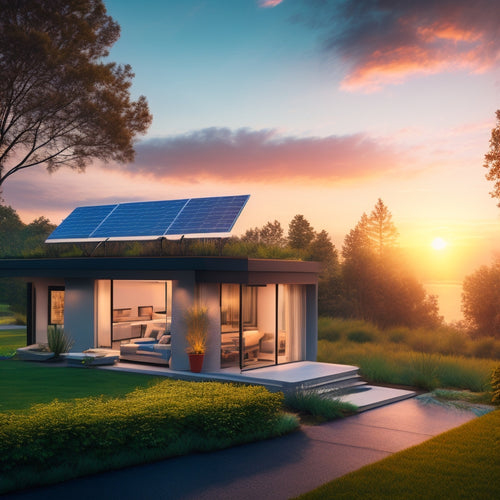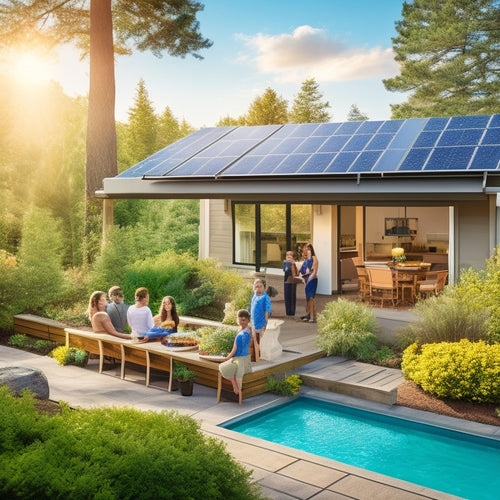
Why Optimize Your Home's Energy Harvesting System
Share
By optimizing your home's energy harvesting system, you can greatly enhance its energy output and savings. You'll maximize your roof space by pinpointing areas that receive the most sunlight, and strategically placing panels to minimize shading and obstructions. This will not only elevate your property value, but also increase its market appeal. Efficient inverter technology and smart system design will further improve energy conversion and storage. By evaluating your energy demands and consumption patterns, you'll be able to make informed decisions to reduce waste and optimize usage. Now, uncover the specific strategies to access your system's full potential.
At a Glance
- Maximizing roof space and optimal panel placement increase energy output and reduce energy bills.
- Energy-harvesting solutions boost property value, making homes more attractive to eco-conscious buyers and increasing resale prices.
- Efficient inverter technology and system design minimize energy losses, contributing to long-term savings and a reduced carbon footprint.
- Analyzing daily energy usage and consumption patterns helps identify areas of inefficiency and informs decisions for energy efficiency.
- Optimizing energy conversion and management enables higher power output, increased energy independence, and a more sustainable future.
Maximize Your Roof Space
When maximizing your roof space for energy harvesting, you'll want to evaluate the size of your roof and how it affects your energy output. A larger roof generally means more space for solar panels, but it's not just about the size - ideal panel placement is essential to utilizing the most energy.
In fact, high-efficiency solar panel systems can provide a higher energy output per panel, allowing for installation on smaller properties while still meeting energy needs Renewable Energy Solutions.
Roof Size Matters
The larger your roof, the more energy you can harvest. This is because a larger roof provides more space for solar panels, allowing you to generate more electricity from the sun.
When evaluating your roof's potential, consider its orientation. A south-facing roof receives the most direct sunlight, making it ideal for energy harvesting. However, even east- and west-facing roofs can still generate considerable amounts of energy.
With an All in One Solar Power System, you can streamline the shift to renewable energy and guarantee a steady power supply. Additionally, such integrated solar solutions can greatly reduce your reliance on costly utility bills from traditional grid sources.
To maximize your roof space, you'll need to conduct a shading analysis. This involves identifying any obstructions, such as trees or neighboring buildings, that could cast shadows on your roof. By understanding the shading patterns, you can strategically place your solar panels to minimize energy loss.
Additionally, consider the roof's pitch and age. A steeper pitch can provide more energy, while an older roof may require replacement before installing solar panels.
Optimal Panel Placement
You've assessed your roof's size and orientation, and now it's time to pinpoint the perfect locations for your solar panels. Maximize your roof space by identifying areas that receive the most sunlight throughout the day.
A shading analysis will help you detect potential obstructions, such as trees, buildings, or chimneys, that could cast shadows on your panels. When it comes to off-grid solar power systems, it's crucial to evaluate the importance of energy independence systems and how they can benefit your home.
Additionally, understanding the benefits of renewable energy systems can help you make an informed decision about your energy harvesting system.
Next, evaluate the panel orientation. The perfect orientation is typically between 15° and 40°, with a south-facing direction receiving the most sunlight.
However, this may vary depending on your location and roof's unique features. A professional installer can help you determine the best orientation for your system.
Boosts Property Value Fast
By integrating energy-harvesting solutions into your home, you'll not only reduce your energy bills but also increase its market appeal.
In fact, a well-designed residential solar installation can markedly reduce your electric bills, making your home more attractive to potential buyers.
This, in turn, can lead to higher resale prices when you decide to sell your property.
In fact, studies have shown that energy-efficient homes can command a premium of up to 10% over similar non-energy-efficient properties.
Increased Market Appeal
Your investment in home energy harvesting can greatly enhance your property's market appeal, making it more attractive to potential buyers.
This increased market appeal comes from the perceived value of energy efficiency and sustainable living that energy harvesting systems provide. As a homeowner, you'll benefit from the ability to showcase your commitment to reducing your carbon footprint and reliance on non-renewable energy sources.
Energy-efficient features, such as solar panels and wind turbines, are highly desirable to eco-conscious buyers.
These features not only reduce energy consumption but also lower energy bills, making your property more attractive to potential buyers. Additionally, energy harvesting systems can increase your property's perceived value, making it stand out in a competitive market.
Higher Resale Prices
Installing energy harvesting systems can greatly enhance your property's resale value, allowing you to reap financial rewards when it's time to sell. In today's real estate market, energy efficiency is a top priority for homebuyers. By optimizing your home's energy harvesting system, you can increase its appeal to potential buyers and command a higher sale price.
| Energy Efficiency Feature | Resale Value Increase | Average Cost |
|---|---|---|
| Solar panels | 3-5% | $15,000 - $30,000 |
| Energy-efficient appliances | 1-2% | $3,000 - $5,000 |
| Insulation and weatherization | 2-3% | $5,000 - $10,000 |
According to the National Association of Realtors, homes with energy-efficient features can sell for up to 10% more than similar homes without them. By investing in energy harvesting systems, you can elevate your property's resale value and attract more buyers. This means you'll have more negotiating power and can sell your home faster. With the rising demand for energy-efficient homes, optimizing your home's energy harvesting system is a smart investment that can pay off in the long run.
Efficient Inverter Technology Matters
When you're optimizing home energy harvesting, you need an inverter system design that guarantees seamless integration with your energy generation and storage systems, such as off grid solar systems that allow for maximum energy independence.
Efficient inverter technology matters because it directly impacts your maximum energy yield, and even small gains in efficiency can add up to significant savings over time, especially when paired with renewable energy storage batteries that provide backup power during outages.
Inverter System Design
Designing an efficient inverter system is an essential step in optimizing home energy harvesting, as it directly impacts the overall performance and reliability of your renewable energy setup.
You want to guarantee that your inverter system can efficiently convert the DC power generated by your solar panels or wind turbines into AC power that's compatible with your home's electrical system.
A well-designed inverter system can greatly improve inverter efficiency, reducing energy losses and increasing the amount of clean energy you can generate.
When selecting an inverter, consider one that offers high efficiency ratings, typically above 95%.
Additionally, look for inverters with advanced grid connectivity features, enabling seamless integration with the grid and allowing you to sell excess energy back to the utility company.
Maximum Energy Yield
Utilizing maximum energy yield from your renewable energy system relies heavily on efficient inverter technology, as it plays a critical role in converting DC power into usable AC power for your home.
You want to guarantee that your system is optimized to produce the most energy possible, reducing your reliance on the grid and maximizing your energy independence.
Efficient inverter technology is key to achieving this goal. By selecting an inverter with high energy efficiency, you can minimize energy losses and maximize your system's overall performance.
Look for inverters with high conversion efficiency rates, typically above 95%, to guarantee that you're getting the most out of your renewable energy system.
When evaluating inverter options, consider sustainable solutions that prioritize energy efficiency.
A high-efficiency inverter won't only reduce your energy bills but also minimize your environmental impact.
Assess Your Energy Demands
You need to understand your daily energy usage to optimize your home energy harvesting system.
By integrating renewable energy solutions into your daily life, you can greatly reduce your reliance on the grid and lower your electricity bills. This involves tracking your energy consumption patterns, including the types of appliances you use, their wattage, and the hours of operation.
Daily Energy Usage
About 30 kilowatt-hours (kWh) of electricity are consumed daily by the average American household, powering everything from lights and appliances to electronics and HVAC systems.
To optimize your home's energy harvesting system, you need to understand your daily energy usage. This involves identifying areas of inefficiency and opportunities to reduce consumption.
Take a closer look at your energy consumption habits. Are you leaving lights, TVs, or computers on for extended periods? Are your appliances energy-efficient? Do you have habits that contribute to energy waste?
By recognizing these patterns, you can make adjustments to reduce your energy consumption. For instance, you can replace incandescent bulbs with LEDs, unplug appliances when not in use, and upgrade to energy-efficient appliances.
These small changes can add up to significant energy savings over time. By evaluating your daily energy usage, you can identify areas for improvement and make informed decisions to increase energy efficiency, ultimately reducing your reliance on the grid and saving you money on your energy bills.
Energy Consumption Patterns
To effectively optimize your home's energy harvesting system, it's essential to pinpoint the periods of highest energy demand. By understanding your energy consumption patterns, you can identify areas where energy efficiency improvements can be made. This involves analyzing your daily energy usage to determine when you rely most heavily on the grid.
Using energy monitoring tools and smart technology, you can track your energy consumption in real-time, providing significant revelations into your energy habits. This data allows you to optimize your energy usage, shifting non-essential loads to off-peak hours or leveraging renewable resources when possible.
By doing so, you can reduce your reliance on the grid, achieving greater energy independence and minimizing your environmental impact. In addition, this approach enables you to adopt eco-friendly practices, reduce cost savings, and integrate your system with the grid more seamlessly.
Higher Energy Conversion Rate
You can markedly increase your home's energy independence by focusing on enhancing power output, which directly impacts your energy conversion rate.
To achieve this, you'll need to optimize your system's design and configuration to maximize energy generation.
Boost Power Output
Three key factors contribute to a higher energy conversion rate in home energy harvesting systems: efficient energy conversion technology, ideal system design, and smart energy management.
By incorporating these components, you'll be able to enhance power output and maximize your energy independence. Efficient energy conversion technology guarantees that the energy generated by your system is converted into usable power with minimal losses.
Ideal system design takes into account factors such as panel angle, orientation, and shading to optimize energy production. Smart energy management systems monitor and control energy production, storage, and consumption to guarantee that your system operates at peak efficiency.
Regular system maintenance is also vital to enhance power output. Dust and debris on solar panels can reduce energy production by up to 25%, so regular cleaning is essential.
Additionally, monitoring energy storage systems and performing routine checks on inverters and other components can help identify potential issues before they impact energy production.
Frequently Asked Questions
Can Energy Harvesting Systems Be Installed in Apartments or Condos?
You can install energy harvesting systems in apartments, but apartment suitability depends on factors like window access and lease terms. In condos, condo limitations like shared walls and roofs may restrict installation, but you can still investigate creative solutions.
Are Energy Harvesting Systems Affected by Weather Conditions?
Just like a sailor adjusts sails to utilize the wind, you'll want to contemplate how weather conditions impact your energy harvesting system's performance, as weather fluctuations can affect energy efficiency - optimizing for maximum output amidst Mother Nature's mood swings.
How Long Does It Take to Install an Energy Harvesting System?
When you decide to install an energy harvesting system, you'll want to know the installation timeline, which typically ranges from a few days to several weeks, depending on installation factors like system size, complexity, and labor availability.
Are Energy Harvesting Systems Eligible for Government Incentives?
You'll be pleased to know that, yes, energy harvesting systems are eligible for government incentives, which can greatly offset installation costs through incentive programs and tax credits, ultimately increasing your energy independence.
Can I Monitor My Energy Harvesting System Remotely?
You can remotely monitor your energy harvesting system, leveraging advanced energy management capabilities to track performance, identify areas for improvement, and optimize energy production, all from the convenience of your mobile device or computer.
Explore More
By optimizing your home's energy harvesting system, you'll reveal its full potential and reap the benefits of sustainable living. Did you know that a typical American home with a solar panel system can save up to $500 per year on electricity bills? By evaluating your energy demands, maximizing your roof space, and utilizing efficient inverter technology, you'll increase your energy conversion rate and enhance your property value. It's time to utilize the power of clean energy and start saving today!
Related Posts
-

Top Eco-Friendly Camping Equipment for a Sustainable Adventure
When you're camping with the planet in mind, opt for eco-friendly gear like tents made from recycled materials and bi...
-

The Future of Residential Energy Storage
The future of residential energy storage looks promising and cost-effective for you. With lithium-ion battery prices ...
-

Top-Rated Home Solar Power Kits for Achieving Energy Independence
Top-rated home solar power kits enable you to achieve energy independence by greatly cutting your energy costs. You c...


